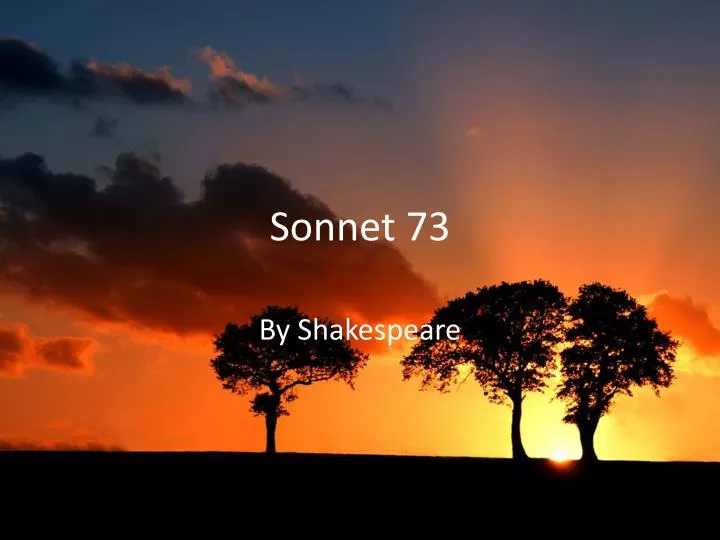

If you have read any of Shakespeare's other sonnets-or indeed, any sonnet in the traditional form-you may recognize this meter. This entry was posted in Shakespeare's Sonnet 73 by Madison Herbert. Certainly, this use of understatement does not serve to reduce the narrator’s emotion concerning his demise, but instead, helps to “convey more depth” (Howe, p.19). Through this, the poet expresses a tragic truth in which much of humanity struggles to accept without experiencing, at the very least, significant uneasiness: death is inescapable and separates us from those we love (whether we’re prepared for it or not). In lines 7-8, I recognized a sort of understatement, as the narrator “implies more by saying less” through his “restrained” characterization of death, which “seals up all the rest” (Howe, p. This duality in definition helps to more effectively accentuate the reality that the liveliness of youth is fleeting and cannot return.
Sonnet 73 free#
This parallels the bare branches of winter, free of “sweet birds.” Approaching the word “choir” as a singing group having been silenced (“ruined”) further emphasizes the lack of spirit and vivacity during the harsh, frigid nakedness of winter, as the “sweet” songs cease to be heard. Firstly, the “ruined choir” (the place) can be understood as a vacant, never to seat a joyous crowd again. With this, the duality of the word helps to further express the fleeting quality of youth by presenting two different but related connotations. In lines 3-4, a more complex metaphor is found within the image of the “sweet birds” upon the “boughs.” In the phase “Bare ruined choir,” the word “choir” can refer to two very different meanings: the singing group and the place where the group is seated within the church building. Moreover, it especially stood out to me that in the third quatrain (lines 9-12) the narrator now realizes and accepts the permanence of death.ģ. I particularly liked the descriptive vocabulary, as well as the impressionable portrayal of fire.

The “glowing” fire signifies the narrator’s dimming youth, as its dull embers will soon expire and turn to “ashes.” While each figure of speech proves to be effective, I prefer the example in 9-12. The narrator shares that he has reached the twilight and the “black night” will soon approach to “take away.” In lines 9-12, symbolism is applied through the image of fire.

More specifically, he continues to enhance the imagery through the personification of the empty night. Moving on to lines 5-8, he transitions from the seasons of the months, to the hours of day–underlining the shortness of life even further. Within lines 1-4, Shakespeare uses a descriptive metaphor to parallel and symbolize the transformation that the poet is experiencing, as their once colorful and lustrous life is expiring. This continuing, but slightly altered, pattern provides the impression that the images are operating in order to help the narrator meet some sort of foreseen end (death).Ģ. Additionally, the employment of repetition helps to create a sense of progression, as the recurring phrase is refined as the poem develops. Immediately following, the poet goes on to compare them-self to this condition–remarking upon their inevitably dwindling youth. For example, the first image describes the changing autumn trees that are soon to be naked to the frigid cold of winter. Likewise, it allows the poet to further accentuate their personal connection and acquaintance with the references made. The use of anaphora in lines 1, 5, and 9, serves to emphasize the images of nature in which the repeated phrases follow.


 0 kommentar(er)
0 kommentar(er)
